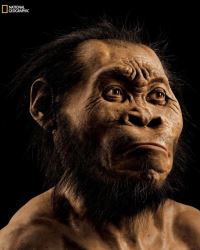Loughborough academics help unearth mystery of new species of human relative

Photo credits: National Geographic
Two of Loughborough University’s growth experts are amongst an international team of scientists studying a new species of human relative discovered in a South African cave.
The new species, Homo naledi, appears to have intentionally deposited bodies of its dead in a remote cave chamber, a behaviour previously thought limited to humans.
Professors Noël Cameron and Barry Bogin of the School of Sport, Exercise and Health Sciences (SSEHS) have been recruited to help determine how close to modern humans the new species, Homo naledi, really is.
The finds are described in two papers published in the scientific journal eLife and reported in the cover story of the October issue of National Geographic magazine and a NOVA/National Geographic Special (#NalediFossils).
Consisting of more than 1,550 numbered fossil elements, the discovery is the single largest fossil hominin find yet made on the continent of Africa. The initial discovery was made in 2013 in a cave known as Rising Star in the Cradle of Humankind World Heritage Site, some 50 kilometres northwest of Johannesburg, South Africa, by University of the Witwatersrand (Wits University) scientists and volunteer cavers. The fossils, which have yet to be dated, lay in a chamber about 90 meters from the cave entrance, accessible only through a chute so narrow that a special team of very slender individuals was needed to retrieve them.
So far, the team has recovered parts of at least 15 individuals of the same species, a small fraction of the fossils believed to remain in the chamber. “With almost every bone in the body represented multiple times, Homo naledi is already practically the best-known fossil member of our lineage,” said Lee Berger, research professor in the Evolutionary Studies Institute at the University of the Witwatersrand and a National Geographic Explorer-in-Residence, who led the two expeditions that discovered and recovered the fossils.
Loughborough’s professors, both internationally recognised experts in the field of human growth and development, were invited to join the research team with the specific aim of studying the post-cranial skeletons of pre-adult individuals.
In the first phase of work they were involved in deciding on the number of individuals represented in the current assemblage and classifying them into age/developmental groups (i.e. infant; young juvenile; older juvenile; young adult; older adult) based on dental morphology and development.
Future work with the post-cranial skeletal material will lead to the description of the pattern of growth characterised by Homo naledi and, critically, reveal differences and similarities to the growth pattern of modern Homo sapiens. The degree of differences and similarities will be critical in determining the proximity of Homo naledi to modern humans.
“This discovery is of great significance; to find post-cranial remains of immature individuals is extremely rare. By determining the pattern of growth we will be able to fix Homo naledi relative to the pattern of growth of great apes and homo sapiens and perhaps to our most recent ape-like ancestors, Australopithecenes, and our earliest human-like ancestors, Homo habilis and Homo erectus.”
Homo naledi was announced today (September 10) by the University of the Witwatersrand, the National Geographic Society and the South African Department of Science and Technology/ National Research Foundation (DST/NRF).